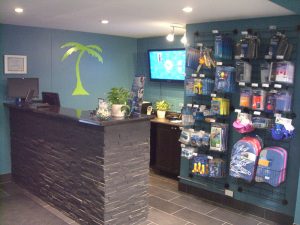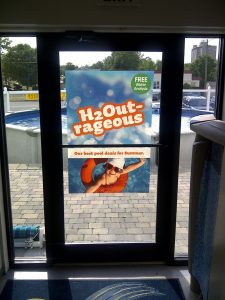Typically, when someone thinks of signage they conjure up images in their head of big block letters on the front of a building or a piece of rectangle-shaped plastic with vinyl letters labeled ‘Pool Store.’ However, this is merely only one type of retail signage, and in some cases these signs may not be the most important.
Change how the consumer thinks
Retail signage can change the way the consumer thinks about a store, the products it sells, and in most cases, they sometimes even encourage them to buy a lot more.
Retail signage can be classified into five distinct categories: promotional, educational, digital, announcement, and lifestyle. A successful swimming pool retail store should have all five to maximize the benefits each sign delivers as they will help pedal the business forward to the next level.
Promotional
From pool stores to coffee shops, promotional signs are the most commonly used sign in every business.
Promotional signs can be seen every day (e.g. ‘Buy one get one 25 per cent off’ or ‘Clearance Sale’ and so on. These signs are effective; however, they need to be brought to another level and work to sell more products rather than simply one or two of something.
For example, what would a consumer say sounds better: ‘Buy two, get the second half off’ or advertising ‘Three for $3’? Consumers today want simplicity and do not want to do math. Therefore, the second option sounds better as the consumer immediately knows if they buy three items it will cost them $3. This is why retailers are seeing volume-based discounts becoming very popular (e.g. five for $5, 10 for $10 and so on).
The same can be said about discount signage. More retailers are leaving the common practice of ‘per cent off’ and using the dollar value savings instead (e.g. instead of advertising 20 per cent off, retailers are now advertising $10 off a $50 purchase.) Once again, in this scenario, the consumer does not need to do any math, they know if they spend $50 they get $10 off.
Remember, simply adding a promotional sign to a display can increase sales of a particular item as much as 12 per cent.
Educational
Dubbed the silent salesperson sign, these work to educate the consumer about the product or service they are looking at.
A recent Wharton School of the University of Pennsylvania study shows consumers want access to the same type of information in a brick-and-mortar retail store as they do online. Therefore, educational signage is needed to help consumers make their buying decisions while they are in the store.
These signs should include information such as the product’s features and benefits, why they should purchase the product over a competitor’s, warranty information, or simply explaining why they need the product they are looking at. Do not assume the consumer knows what they are looking at or what the item does.
These signs can be taken to the next level by adding QR codes. Once the consumer scans one of these codes with their smartphone, they are immediately taken to a website (e.g. YouTube) where they can watch a product demonstration video or to another website that has given the company and/or product a positive review.
Digital
Consumers are drawn to digital displays, the glow from a TV display or the motion of something projected on the store’s windows or walls grabs the consumer’s attention.

Digital displays mounted behind the store’s water lab counter can be used to show images of the store’s work, available product, or even a menu of available services.
Not all digital displays need to be expensive kiosks. They can simply comprise digital photo frames that show a picture of the item and what the price is. Video can even be loaded to really get the consumer’s attention.
One way of doing this is to mount one or more 42-in. TVs behind the store’s water lab counter. Here, images of the store’s work, video showing available products, or even a menu of available services can be displayed via slide show presentations created using software such as Microsoft PowerPoint. Going one step further, these digital signs can also be used to deliver fun swimming- or pool-related facts (e.g. elephants can swim as many as 22 km [20 miles] a day—they use their trunks as natural snorkels).
Announcement
Announcement signs are typically known as the ‘negative’ sign. A few examples include: ‘Do not touch,’ ‘Parents are responsible for their children,’ ‘No returns on chemicals,’ ‘$10 water test if nothing is purchased.’
Retailers typically vent their frustrations on the consumer by using these signs. Store owners/operators should keep in mind, however, these negative signs end up punishing 95 per cent of the people who follow the rules just to keep the five per cent in line. Rather, a ‘Store Policy’ sign, posted behind the counter, should be used to list legalese or stipulations of a purchase.
Do not clutter the store and displays with negativity. Instead, use announcement signs to set the consumer’s mood. For instance, phrases like ‘Now entering fun,’ ‘No shoes, no shirt, no problem,’ or ‘Free smiles, and water tests too’ are great examples. The swimming pool industry is a fun business; make the consumer feel that way.
Lifestyle

Lifestyle images and signs throughout a retail environment set the tone and mood for the consumer, allowing them to picture ownership or a lifestyle.
These signs paint the picture of ownership. They show the consumer how they would feel if they owned the product or paid for a service.
Lifestyle images and signs throughout a retail environment once again sets the tone and mood for the consumer and, for a moment, takes them away from the problems and stresses of daily life by picturing ownership or a lifestyle.
Signs are key to retail success
Signs can play a vital role in the success of a retail store. Retailers should never assume the consumer knows or understands the products in their store. Therefore, every retailer is encouraged to go through their store using the ‘pedal’ strategy. Do not let the business simply coast on autopilot, ‘pedal’ it and see how it can help the business.
This article was written by Ted Lawrence and originally appeared on Pool & Spa Marketing [link].
